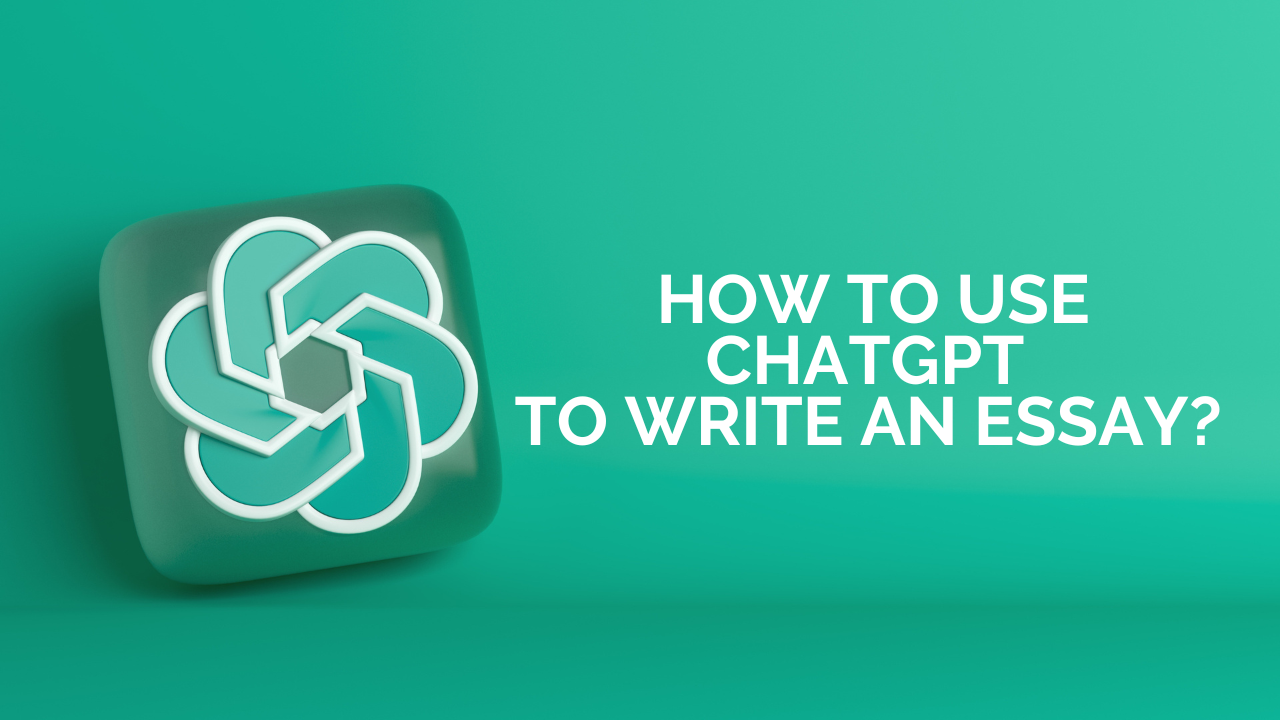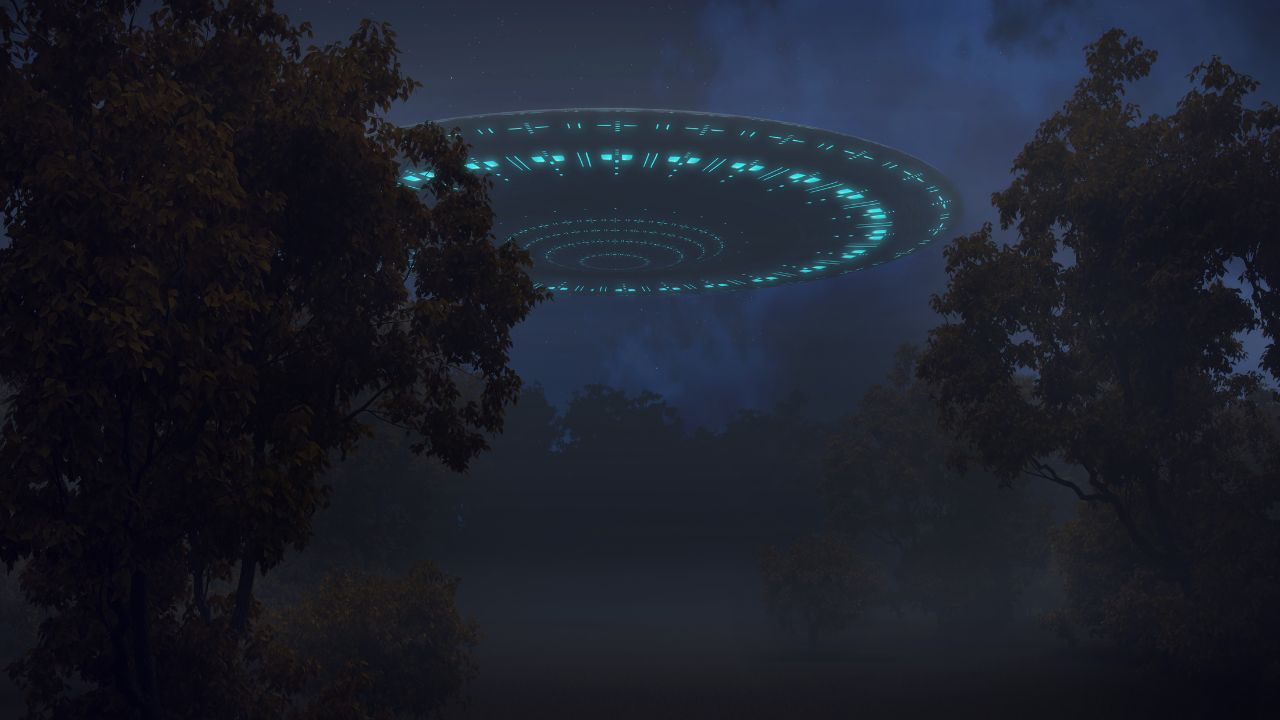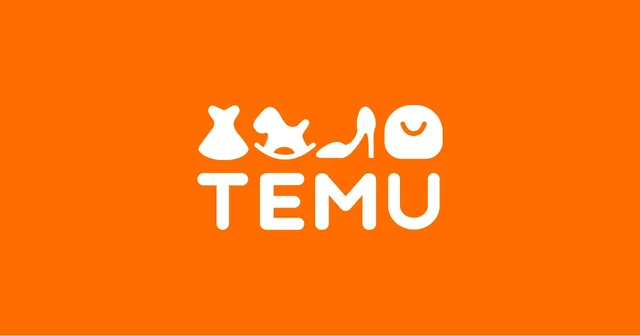Back in college, the mere sight of a new essay assignment would send my heart sinking like a stone. And no, it wasn’t just about being lazy—okay, maybe just a little. The truth is, there were plenty of other reasons why I dreaded the essay grind. I bet some of you can relate, right?
I mean, picture this: you’re juggling classes, exams, maybe a part-time job, and then bam! Another essay lands on your plate. It’s like a surprise pop quiz for your stress levels. But you know what my biggest peeve was? I spent hours, maybe even nights, crafting words for an essay unrelated to my major. Talk about frustrating.
But I made it. I’m not afraid of writing essays anymore. On the contrary, I’m enjoying the process of writing. How did that happen? How to Use ChatGPT to Write an Essay?
Yeah, I see that spark of curiosity. Please keep reading and learn my tricks for using ChatGPT to write an essay.
How to Use ChatGPT to Write an Essay in 6 Steps?
Let’s break it down. I have a simple roadmap. Grab your virtual pen because we’ll explore the 6 steps to make ChatGPT your essay-writing sidekick. Let’s dive in!
Step 1: Generate Essay Ideas
When I felt stuck or couldn’t decide on a topic, I turned to ChatGPT for inspiration. It’s like having a brainstorming buddy available 24/7. I’d start by providing a general idea or keyword related to the subject. And ChatGPT would start firing back with potential essay topics. It could be as simple as typing “environmental issues” or “space exploration.”
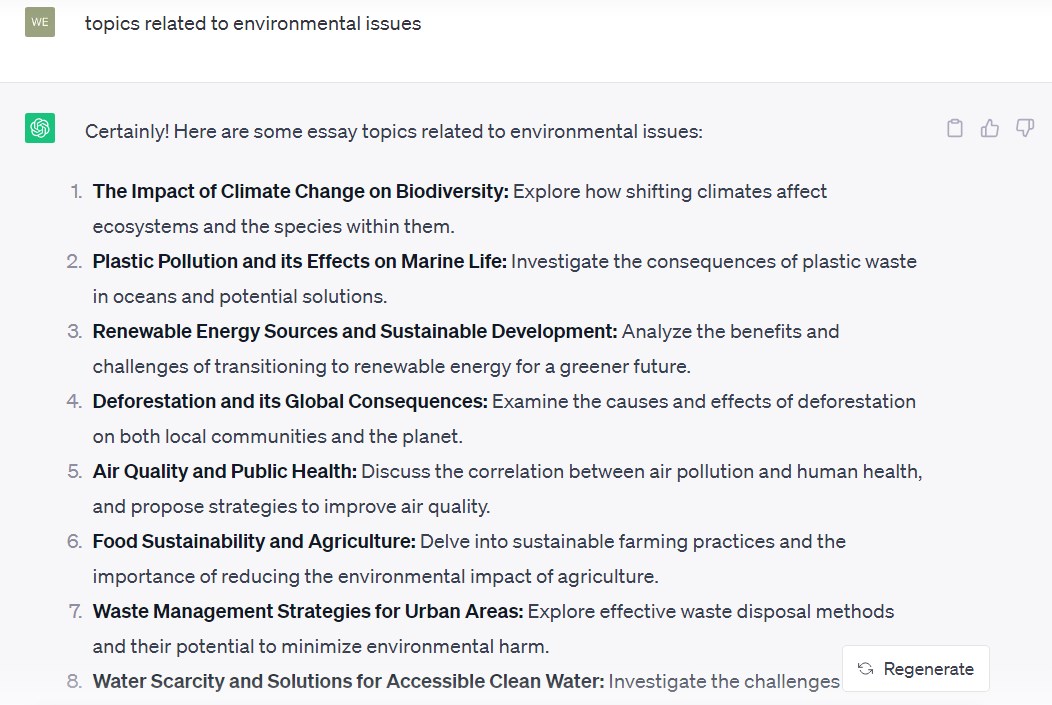
Then, ChatGPT would churn out a list of intriguing topics.
It was like having a personal idea generator at my disposal. Of course, only some suggestions were good, but it got the creative juices flowing.
Step 2: Use ChatGPT to Do the Research
When digging up facts and figures for my essays, I discovered a true gem in ChatGPT. Researching became less of a chore and more of a collaborative effort. Here’s how ChatGPT helped me navigate the sea of information:
I’d outline the type of information I needed. Then, ChatGPT would provide me with relevant sources, explanations, and concise summaries.
For instance, I needed to explore plastic pollution’s effects on marine life. I asked ChatGPT for statistics on ocean plastic waste and its impact on different species. Voila! It gave me a handful of stats and insights, saving me time and effort to scour through lengthy research papers.
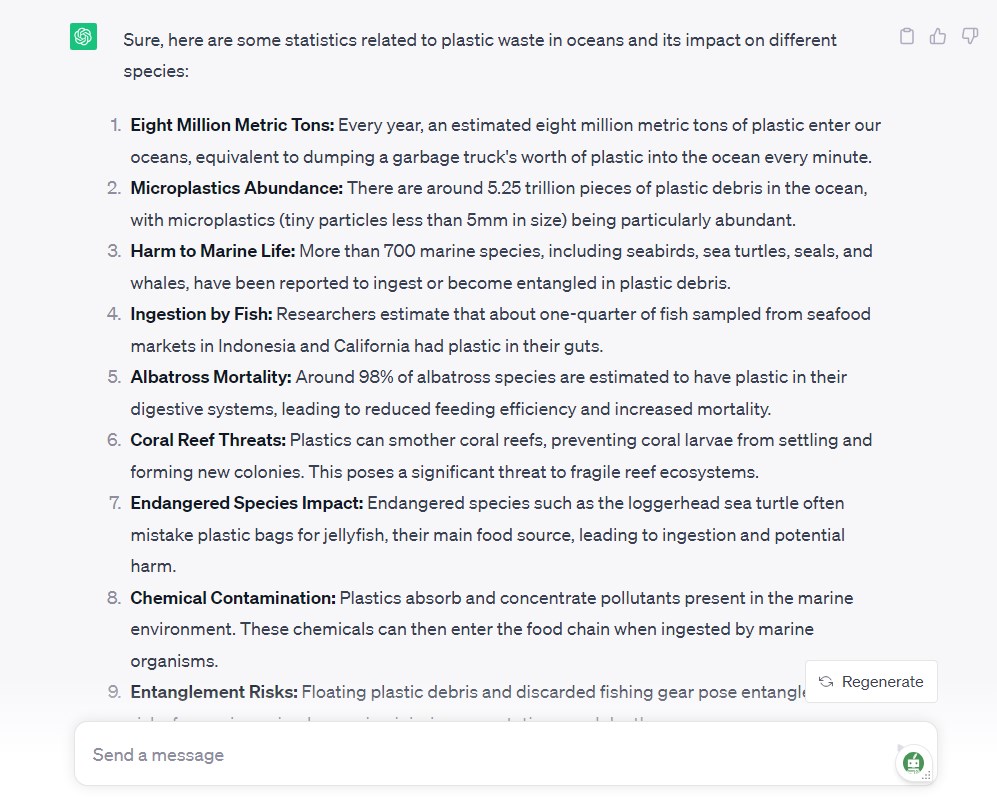
Not only that, but ChatGPT also helped me find reputable sources that I might have missed otherwise. If I needed recent studies or reports, I’d ask for recommendations, and ChatGPT would provide me with a list of relevant sources.
The key here was to ask specific questions and guide ChatGPT towards the information I sought.
Attention: ChatGPT can only offer information available up until September 2021. So, if you need the latest source and data, ChatGPT won’t be a good helper.
Step 3: Generate the Essay Outline with ChatGPT
You know that feeling when you stare at a blank screen, wondering how to structure your essay? Yeah, I’ve been there too. That’s when ChatGPT became my trusted guide. I’d feed it the main points I wanted to cover. Then, it would help me create a coherent outline as a roadmap for my essay.
I was tackling an essay about the importance of renewable energy sources. I’d chat with ChatGPT and provide the key ideas I wanted to discuss. Take solar power and its environmental benefits as an example. Then, ChatGPT would organize these points logically, giving subpoints and connections between them.
Step 4: Write an Engaging Introduction
Have you ever stared at a blank screen, struggling to find the perfect words to start your essay? Yeah, that was my story, too. But with ChatGPT as my trusty companion, things got interesting. I’d share a bit about my topic and ask ChatGPT for creative prompts to get the ball rolling.
For instance, if I were writing about the impact of technology on society, I’d tell ChatGPT, “Hey, I’m exploring how technology shapes our lives. Can you give me a few opening lines to grab readers’ attention?” And just like that, ChatGPT would come up with intriguing hooks like:
- “In a world where our daily lives are inseparable from our screens…”
- “Imagine a time when a single click had the power to reshape industries…”
- “As the digital age sweeps us into its embrace, we ponder…”
These prompts weren’t just ordinary sentences; they were doorways into my essay that welcomed readers with open arms. I could pick the one that resonated most with my theme, and suddenly, my introduction was alive and kicking.
Using ChatGPT to brainstorm introductions saved me time and injected a dose of creativity that I sometimes struggled to summon on my own. It set the tone for the entire essay and got my readers curious about what lay ahead.
Step 5: Generate Paragraphs based on the Outline and Theses
Generating paragraphs used to be a puzzle. I had all these great ideas from my outline, but putting them into words? That’s where ChatGPT stepped up and lent a helping hand.
Here’s the trick: I’d take a section from my outline, like the one about the environmental benefits of renewable energy, and give ChatGPT a nudge. I’d say, “ChatGPT, can you help me flesh out the benefits of renewable energy for the environment? Give me some examples that drive the point home.” And just like that, ChatGPT would start weaving its magic:
- “Renewable energy sources, such as solar and wind power, lead the charge in reducing greenhouse gas emissions. By harnessing the sun’s rays and the power of the wind, we’re decreasing our reliance on fossil fuels that contribute to global warming…”
- “Picture a world where our energy needs are met by rivers and tides, churning out electricity without spewing out pollutants. That’s the promise of hydroelectric and tidal energy, which tap into nature’s forces to provide clean power…”
These prompts weren’t just words; they were building blocks for my paragraphs. ChatGPT gave me the ideas, examples, and even some eloquent phrasing to breathe life into my essay. I’d take what it generated, tweak a word or two to fit my style, and voila! My outline was gradually turning into a full-fledged essay.
Step 6: Generate a Convincing Conclusion
Crafting a conclusion that leaves a lasting impact used to be a tough nut to crack. But with ChatGPT on my side, wrapping up my essays with a convincing conclusion became a breeze. Here’s how I turned my final words into something truly remarkable.
For example, I was writing about the benefits of embracing diversity. I’d say, “ChatGPT, I want my conclusion to drive home the idea that diversity strengthens communities. Can you give me a few closing lines that wrap up my essay on a high note?” And like a true magician, ChatGPT would conjure up lines like:
- “As we celebrate the vibrant tapestry of human differences, we’re not just embracing diversity. We’re weaving a stronger social fabric that holds us all together.”
- “Diversity isn’t just a concept in a world that thrives on connections. It’s the glue that binds us, making our communities resilient and our future promising.”
These prompts weren’t just lines; they were the final brushstrokes on my essay’s canvas. ChatGPT nudged me in the right direction, helping me craft a conclusion that echoed the essence of my essay’s journey.
The best part? I could choose the lines that resonated most with my essay’s tone and message. It transformed my ending from a mere wrap-up to a powerful call to action or a thought-provoking reflection.
ChatGPT Prompts to Maximize the Potential
Generating essay ideas with ChatGPT can be a breeze with the right prompts. Here are a few awesome prompts you can use to kickstart your creative process.
For Essay Ideas:
- “I’m in need of essay ideas that discuss the ethical dilemmas posed by genetic engineering. Can you guide me with some intriguing angles to explore?”
- “I’m passionate about the effects of social media on mental health. Could you help me generate essay ideas that delve into the impact of online platforms?”
- “I’d like to write an essay about the changing dynamics of remote work. Can you give me some essay topics that highlight the challenges and opportunities?”
- “ChatGPT, I’m interested in environmental conservation. Can you assist me in brainstorming essay ideas that emphasize practical solutions to reduce pollution?”
- “I want to explore the intersection of culture and technology in my essay. Can you provide me with topics that highlight how digital platforms affect cultural expressions?”
- “I’m thinking of writing an essay on the significance of renewable energy sources. Could you help me generate impactful essay ideas related to sustainability?”
To Do the Research:
- “ChatGPT, I’m researching the benefits of mindfulness meditation. Can you provide me with recent studies highlighting its effects on stress reduction?”
- “I’m diving into the history of space exploration. Could you help me find key milestones and notable achievements in the field of astronomy?”
- “I’m exploring the impact of climate change on marine ecosystems. Can you suggest reputable sources that discuss the effects on coral reefs and marine biodiversity?”
- “ChatGPT, I need information on the economic implications of renewable energy adoption. Could you point me to research examining job creation and market growth?”
- “I’m curious about the psychological benefits of outdoor activities. Can you help me find studies that link spending time in nature with improved mental well-being?”
To Generate the Essay Outline:
- “ChatGPT, I need an outline for my essay on the benefits of mindfulness meditation. Can you help me structure the main points and subpoints?”
- “I’m writing an essay about the impact of climate change on coastal communities. Could you assist me in creating a comprehensive outline that covers the key aspects?”
- “I want to explore the evolution of artificial intelligence for my essay. Can you provide an outline highlighting the historical progression and future trends?”
- “ChatGPT, I’m crafting an essay about the pros and cons of social media. Could you help me outline the advantages, drawbacks, and potential solutions?”
- “I’m focusing on the role of women in STEM fields for my essay. Can you outline the challenges, achievements, and initiatives supporting gender diversity?”
To Write an Engaging Introduction:
- “ChatGPT, I’m starting an essay about the challenges of modern communication. Can you help me draft an attention-grabbing introduction that sets the tone for the essay?”
- “I want my essay about the mysteries of deep-sea exploration to begin with a bang. Could you provide me with an intriguing opening that sparks curiosity?”
- “Hey ChatGPT, I’m writing about the impact of virtual reality on education. How about helping me create an introduction that instantly hooks readers?”
- “I’m tackling an essay on the power of storytelling. Can you help me come up with an introduction that weaves a narrative to draw readers in?”
- “I need to write an essay about the psychological effects of color in design. Can you suggest an introduction that uses vivid imagery to captivate readers?”
To Generate Content for Subtopics:
- “I’d like to explore the impact of technology on education. Do you know how digital tools are reshaping the classroom experience and enhancing learning outcomes?”
- “Hey ChatGPT, I’m focusing on the role of social media in shaping cultural norms. Can you give me insights into how online platforms influence societal perceptions and behaviors?”
- “I’m curious about the future of healthcare technology. Could you analyze how AI and telemedicine are revolutionizing patient care and medical diagnoses?”
- “ChatGPT, I’m working on an essay about urban planning and sustainability. Can you explain how green infrastructure promotes energy efficiency and enhances urban environments?”
- “I want to discuss the ethical considerations of genetic engineering. Could you generate content that explores the potential benefits and risks of altering human DNA?”
Bonus: 3 Essay Outline Templates
Now you must know how to generate essay content with awesome ChatGPT prompts. Here’s a bonus for you: examples of essay outline templates in different types.
Argumentative essay outline
Firstly, let’s take an example of an argumentative essay outline. The topic we give the AI is “ChatGPT’s positive and negative impact on society.”
Expository essay outline
Next, we’ll explore another insightful example. It’s an expository essay outline that delves into the dangers of AI in the arts and content creation.
Literary analysis essay outline
Lastly, we’re about to uncover an example of a literary analysis essay outline. This time, we generate an outline template for “Sigmund Freud’s psychoanalysis of characters in the novel “Beloved.” “


